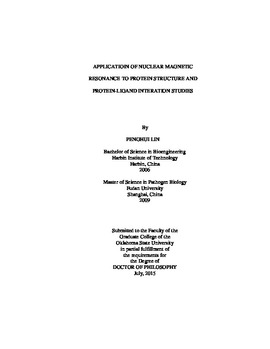| dc.contributor.advisor | Zhou, Donghua H. | |
| dc.contributor.author | Lin, Penghui | |
| dc.date.accessioned | 2016-09-29T18:40:54Z | |
| dc.date.available | 2016-09-29T18:40:54Z | |
| dc.date.issued | 2015-07 | |
| dc.identifier.uri | https://hdl.handle.net/11244/45273 | |
| dc.description.abstract | NMR (Nuclear Magnetic Resonance) has been expanding its application since it was first discovered in the early 50s. In biophysics, it is a very powerful tool complement to X-ray crystallography for protein structure studies. In this dissertation, two different projects studied by two different NMR methods will be presented. In the first part, a membrane protein PLIN1 which resides on the surface of the cellular organelle lipid droplet is investigated by solid-state NMR (ssNMR). It has been shown that PLIN 1 exclusively locates on the surface of lipid droplet and upon phosphorylation, recruits lipase to digest the triglycerides stored in the lipid droplet. However, due to its membrane protein nature, its insolubility resists to crystallization. ssNMR is a perfect tool to study this membrane protein. PLIN1 was reconstituted into DMPG liposomes and multi-dimensional ssNMR spectra were acquired. According to proton spin diffusion data, a membrane interaction model was proposed and later verified by both molecular dynamics (MD) simulation and experimental reconstitution data. In the second part, a soluble protein Mortalin was studied by solution NMR. Mortalin is a heat shock protein 70 (HSP70) family membrane primarily located in the mitochondria. In cancer cells, Mortalin is released to the cytoplasm and forms a complex with p53, sequestering it in the cytoplasm thus inhibiting its translocation to nucleus to induce cell apoptosis. The flexible heteroarotinoid (Flex-Het) SHetA2 with promising anti-cancer activity can bind to Mortalin and release p53 from the complex to induce cell apoptosis. We successfully determined the substrate binding pocket of Mortalin to be the interacting sites with SHetA2 by chemical shift perturbation (CSP). Using AutoDock as the prediction tool, at least two binding configurations of SHetA2 are generated with high binding affinity. According to these results, more SHetA2 analogs were designed and tested in AutoDock. We find that the analogs with longer linkers that can occupy both configurations of SHetA2 yield the highest binding affinity (lowest binding energy). These results will guide future drug designs to increase the efficiency of Flex-Het anti-cancer activity. | |
| dc.format | application/pdf | |
| dc.language | en_US | |
| dc.rights | Copyright is held by the author who has granted the Oklahoma State University Library the non-exclusive right to share this material in its institutional repository. Contact Digital Library Services at lib-dls@okstate.edu or 405-744-9161 for the permission policy on the use, reproduction or distribution of this material. | |
| dc.title | Application of nuclear magnetic resonance to protein structure and protein-ligand interaction studies | |
| dc.contributor.committeeMember | Xie, Aihua | |
| dc.contributor.committeeMember | Deng, Junpeng | |
| dc.contributor.committeeMember | Liu, YingMei | |
| osu.filename | Lin_okstate_0664D_14147.pdf | |
| osu.accesstype | Open Access | |
| dc.type.genre | Dissertation | |
| dc.type.material | Text | |
| thesis.degree.discipline | Photonics | |
| thesis.degree.grantor | Oklahoma State University | |
